Spotting wildlife in the Galapagos Islands is an experience like no other. Situated in the Pacific Ocean nearly 600 miles off the coast of Ecuador, the archipelago boasts a rich biodiversity that unfolds as a breathtaking spectacle. From playful sea lions to majestic giant tortoises, the islands harbor a staggering array of species, many of which are found nowhere else on Earth.
To truly appreciate the unique wildlife of the Galapagos, there’s no better vantage point than the deck of a luxury cruise yacht. Sailing from one volcanic island to the next, guests are immersed in the profound seascape that shaped Charles Darwin’s theory of evolution. In this living laboratory, where Mother Nature calls the shots, no two cruises are exactly alike. Whether observing from the outer deck or traversing the islands by boat or foot, be prepared to witness the kaleidoscope of wildlife in Galapagos.
For gay travelers seeking an exclusive and comfortable adventure, a Galapagos Islands luxury cruise tailored for the LGBTQ+ community offers the perfect blend of leisure and luxury. Lavish yet intimate cruise ships provide a safe and supportive social environment. Amidst guided excursions to encounter sea lions, marine iguanas, giant tortoises, birds, and more in their natural habitat, passengers can relax and enjoy with like-minded travelers.
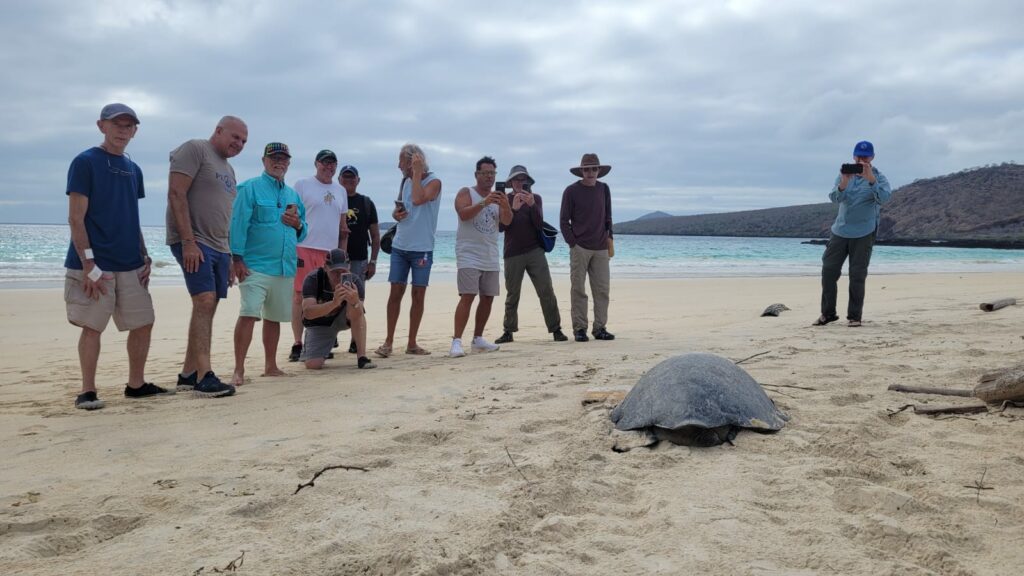
The best Galapagos Islands luxury cruises also have onboard expert guides to enhance the wildlife-watching experience by helping passengers spot creatures, both large and small, and sharing little-known facts. The crew goes the extra mile to ensure that all travelers feel welcomed and at ease to be themselves throughout the expedition. In this guide, we’ll delve into the diverse habitats and ecosystems, revealing the secrets to maximizing your wildlife encounters in the enchanting Galapagos Islands.
Marine Life
The glistening Galapagos waters are home to an array of marine creatures. See wildlife up close and appreciate their natural behaviors from a safe yet intimate distance aboard your gay Galapagos cruise. Here is a glimpse into the diversity below the surface.
Sea lions
Playful sea lions are a hallmark of the Galapagos experience. From imposing males guarding harems to squealing pups wrestling in the surf, the sight of these charismatic creatures basking on shore or floating lazily offshore never grows old. Dare to linger near a colony and you may spot one or two stretching their curiosity to greet swimmers and kayakers.

Dolphins
Frolicking pods of bottle-nosed dolphins often delight passengers on boat transfers between islands. Their acrobatic antics and willingness to bow-ride vessel wake leave many with lasting memories.
Galapagos Penguins
Though surprising given their proximity to the equator, penguins call the Galapagos home. Admire these iconic black and white residents as they waddle, swim and socialize along rocky shoreline areas. Their fearless but adorable curiosity may allow an up-close encounter.
Whale watching (seasonal)
There is no better way to appreciate the majesty of the ocean’s mightiest mammals than from the rolling deck of a boat. During the cooler months, various species of whales can be spotted breaching and flashing their flukes just offshore. Humpbacks in particular indulge in spectacular acrobatic displays, somersaulting, twisting and waving their pectoral fins in fantastical underwater ballets.
Look closely, and you may spot the uncommon Bryde’s whale or the almost entirely black Fin whale, the second-largest creature on Earth. Keep your binoculars at the ready and listen for the blow of spray as the giants of the deep come up for air. You never know what sublime sight may greet your eyes.
Sharks and manta rays
Diving or snorkeling offers an up-close look at marine life not seen from on deck. Silky sharks glide effortlessly in synchronized schools while enormous mantas soar gracefully through sun-dappled waters. Keep watch below and you may even spot a scalloped hammerhead shark or a thresher shark swing its scythe-like tail high above the waves.
Land Animals
The unique volcanic landscapes of the Galapagos Islands give rise to some truly remarkable creatures that call the shore their home. From the towering scales of a giant tortoise to the cunning tactics of Darwin’s foxes, these Galapagos Islands animals on land offer an unforgettable adventure for LGBTQ+ travelers exploring the islands.
Giant tortoises
Lumbering across the lava fields and highlands, these ancient giants show nature’s penchant for survivorship. Weighing several hundred pounds, these long-lived reptiles can live over 100 years and are the longest-living vertebrates on Earth. Their leathery shells have sheltered them through vast sweeps of time, bearing witness to evolution itself from their mobile homes.
Marine iguanas
While most iguanas prefer dry land, the marine iguana is uniquely adapted to the ocean. Growing over 5 feet in length, they gather in colonies along rocky coastlines. With leathery skin and feet evolved into flippers, they navigate the choppy Galapagos surf with shocking agility.

Their feeding method is perhaps their most startling innovation – by grazing on algae in rocky tidepools, they have evolved the ability to spend extensive periods underwater filtering their preferred meal through specialized teeth and jaws. With bodies honed by millennia of constant changes in the sea, marine iguanas showcase nature’s talent for transformation no less than the islands’ other remarkable animals.
Land iguanas
Towering up to 5 feet tall, the endemic land iguanas of the Galapagos are a truly magnificent sight to behold. In contrast to their amphibious cousins, land iguanas cling stubbornly to their terrestrial domain. While lacking the aquatic specializations of the marine iguana, they possess defensive armoring and claws well-suited to surviving in the islands’ thorny vegetation. Land iguanas showcase a wide spectrum of morphologies evolved to specific island ecologies, from the bulky land giants of Santa Cruz to the svelte racers of Isabela Island.
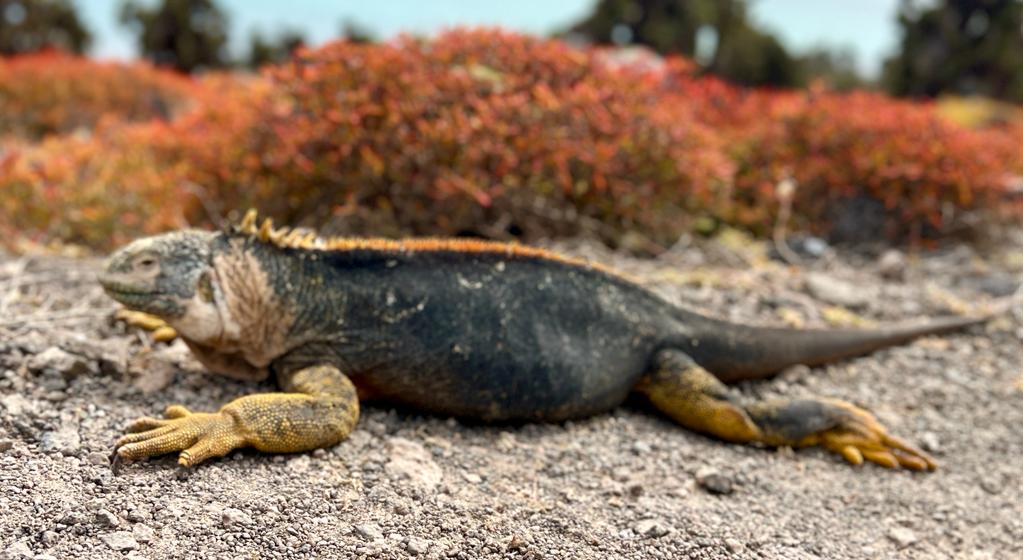
Galapagos hawks
With their sharp eyes and sly maneuvers, the acrobatic Galapagos hawk puts on quite a show in the skies above the islands. These endemic raptors are masters of the hunt, using keen vision to spot small reptiles and birds hunkering below. Don’t blink or you may miss them plunge from above at breakneck speeds to snatch unsuspecting prey in their talons.
Even from afar, the unique color patterns of dark brown and cryptic white make these raptors easy to identify as they soar on thermal air currents. Watch and see if a crabby encounter ensues when two hawks battle it out for a carcass.
Darwin’s foxes
Ever elusive yet endearing, the miniature Darwin’s fox remains one of the hardest Galapagos animals to spot. Camouflaged by their salt-and-pepper fur, these inquisitive canines creep among the lava rocks and scrub, foraging mostly at dawn and dusk. Your best chance for a glimpse is on Isla Santiago, their last remaining stronghold. With patience and luck, you may spot one peeking out from the undergrowth.
Bird Watching
Birdwatching in the remote Galapagos Islands offers an unparalleled experience for gay travelers. Sailing between the islands aboard a luxury yacht, you’ll be immersed in spectacular coastal panoramas alive with an awe-inspiring array of endemic bird species. Expert guides help passengers spot rare seabirds from the ship’s outer decks, while inland excursions unveil new avian treasures around every volcanic corner. With over twenty species found only in the archipelago, the islands boast a dazzling diversity of feathered friends perfectly adapted to their isolated home.
Blue-footed boobies – With their iconic teal feet and sky-blue plumage, these acrobatic performers never fail to amuse audiences. Watching male blue-footed boobies perform their whimsical mating dance, their cobalt blue feet kicking energetically as if in rhythm to an unheard samba beat, is pure joy.
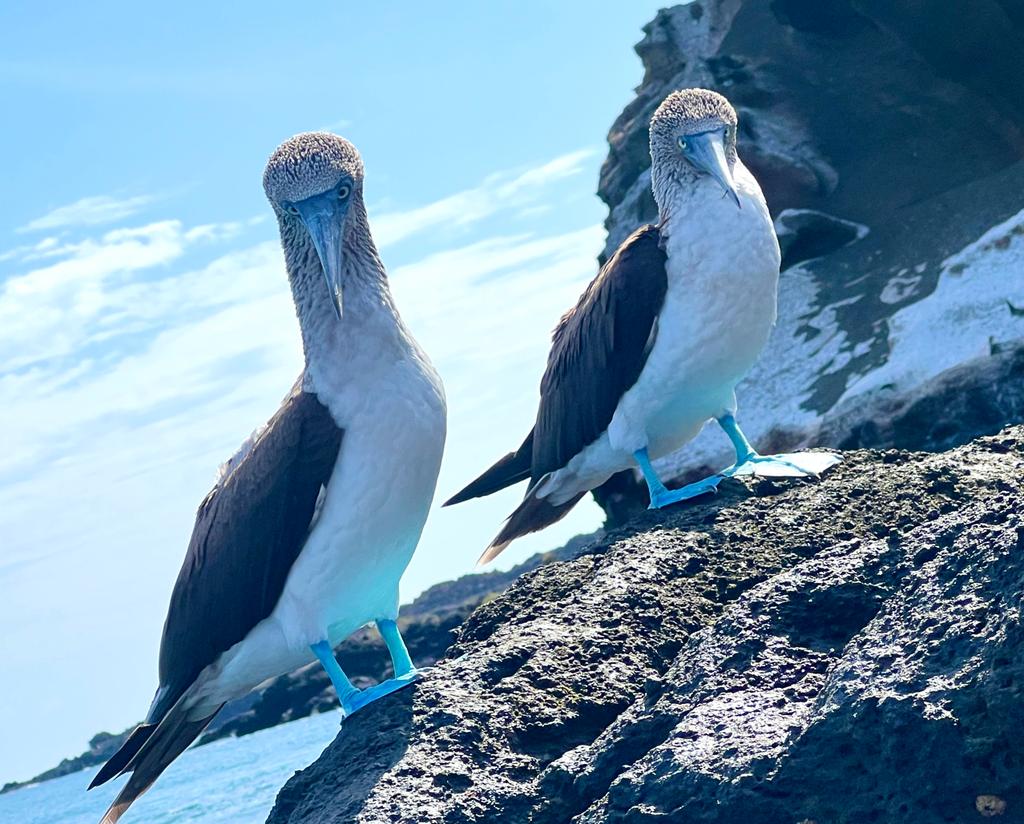
Red-footed boobies: Marvel at the captivating red-footed boobies in the Galapagos, distinguished by their vibrant red webbed feet and a distinctive white and brown plumage blend. Unlike their blue-footed counterparts, who typically nest on the ground, these birds exhibit adaptability by choosing tree nests.
Frigatebirds: Masters of the thermals, frigatebirds soar on wings that span up to 6 feet with seemingly little effort. Both males and females have a naked red gular sac under their beaks that the males inflate to an enormous size during courtship displays, making quite a striking sight.
Darwin’s finches: It was studying these finches of various beak shapes that helped Darwin develop his theory of evolution. Darwin’s finches are some of the tiniest yet most famous feathered residents. Delicate and diverse, over a dozen species of finch exhibit varying beaks uniquely adapted for specific food sources like seeds and insects. Patient visitors can glimpse the subtle differences that contributed to Darwin’s theory of natural selection.
Flamingos – In the interior lagoons of the northern side of Santa Cruz island, flocks of rose-pink flamingos can be spotted from afar in their iconic stance, gracefully filtering microscopic algae and shrimp from the shallow waters. Their vibrant plumage is a beautiful addition to the landscape.
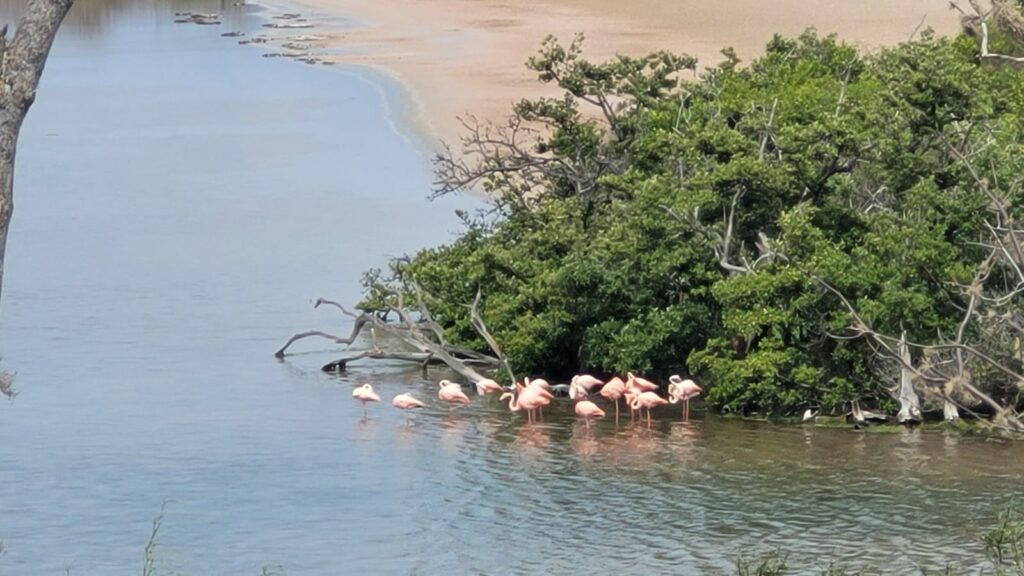
Short-eared owls
Roving the lowlands and coastal scrub comes a ghostly specter of feather and talon—the short-eared owl. Elusive masters of camouflage, spotting these secretive hunters requires keen eyes and a fair dose of luck. Their mottled plumage grants perfect camouflage from prey and predator alike. With acute hearing and precision strikes, they reign as ghostly Galapagos night hunters.
Flightless cormorants
Perched precariously on rocky shorelines, the stocky yet charming flightless cormorant relies entirely on its webbed feet to navigate the sea. Having lost its ability to fly over generations of living free from predators on the remote islands, its vestigial wings now serve solely to aid swimming and balance. Waddling around the rocky coasts and diving for fish, they are an odd yet endearing sight. Their featherless blue skin and perpetually wet appearance attracts amused attention from passersby.
Tips for an Unforgettable Wildlife Viewing Experience in the Galapagos Islands
Exploring the Galapagos Islands is a special privilege that comes with a simple yet crucial responsibility – navigate with care. By embracing these tips and observing proper etiquette, you not only maximize your enjoyment but also play a crucial role in safeguarding this ecological wonder for future generations.
- Respect Wildlife Distances: Maintain a respectful distance from the Galapagos Islands animals to avoid causing stress or disturbance. Follow the guidance of expert guides to ensure a safe yet immersive encounter. Never pursue, encircle, or trap them.
- Silence is Golden: Keep noise to a minimum during wildlife observations. The Galapagos Islands thrive on the natural sounds of the environment, and a hushed atmosphere enhances the experience for both visitors and inhabitants.
- Follow the Guide’s Lead: Expert naturalist guides accompany adventurous gay travelers on excursions. Adhere to their instructions, as they possess valuable knowledge about the wildlife in Galapagos.
- Use Eco-Friendly Sunscreen: Opt for reef-safe and biodegradable sunscreen to protect yourself without harming the marine life when snorkeling or swimming.
- No Touching or Feeding: Do not touch or feed the wildlife. This helps maintain their natural behaviors and prevents the transmission of diseases.
- No Trace Travel: Abide by the principle of “leave no trace.” Refrain from touching, feeding, or attempting to interact with the animals. This helps maintain the natural behaviors and health of the wildlife.
- Photography Etiquette: Capture the beauty of the Galapagos without disrupting the environment. Use silent camera settings, avoid flash photography, and be mindful of your surroundings to prevent disturbing animals or their habitats.
- Mind Your Step: Stick to designated trails to protect fragile ecosystems. Avoid wandering off the path, as the unique flora and fauna of the Galapagos are often adapted to specific conditions.
- Snorkeling and Diving Etiquette: When engaging in water activities, maintain a safe distance from marine life, including sea lions and turtles. Use reef-safe sunscreen to protect the delicate underwater ecosystems.
- Be Weather-Ready: The Galapagos weather can be unpredictable. Pack layers, including a light jacket, sunscreen, a hat, and comfortable footwear suitable for both land and water activities.
- Stay Hydrated: The equatorial sun can be intense. Carry a reusable water bottle to stay hydrated, especially during excursions. Many luxury cruises provide water refill stations onboard.
- Be Mindful of Fellow Travelers: The Galapagos Islands attract nature enthusiasts from around the world. Be considerate of your fellow gay travelers, allowing everyone to enjoy the breathtaking landscapes and wildlife encounters.
- Learn About the Species: Familiarize yourself with the diverse species inhabiting the islands. A pre-trip study enhances your appreciation and understanding of the unique flora and fauna.
- Support Conservation Efforts: Contribute to the preservation of the Galapagos by supporting local conservation initiatives. Learn about ongoing projects and consider making a donation to organizations dedicated to protecting this extraordinary ecosystem. Make sure to visit the breeding center Centro de Crianza Fausto Llerena and the Charles Darwin Research Station in Puerto Ayora, Santa Cruz, on your Galapagos Islands luxury cruise.
The Importance of Ecotourism and Conservation
As you immerse yourself in the extraordinary beauty and wildlife of the Galapagos Islands, it’s crucial to acknowledge the vital role of ecotourism and conservation. The delicate balance of nature, which you are fortunate to witness during your journeys, underscores the importance of responsible travel.
Ecotourism in the Galapagos extends beyond mere enjoyment of breathtaking landscapes and rare species; it serves as a lifeline for the archipelago’s fragile ecosystems. Choosing tours that prioritize environmentally friendly practices and adhere to strict conservation guidelines allows you to actively participate in preserving this natural wonder.
Guided through the islands by expert naturalists who share their knowledge and passion, embrace the opportunity to deepen your understanding of the interconnectedness of all living things. The conservation of the Galapagos Islands is not just a responsibility but a shared commitment to safeguarding the planet’s biodiversity.
By choosing sustainable and eco-conscious travel experiences when visiting the Galapagos Islands, you not only create lasting memories but also become stewards of the remarkable biodiversity that defines it.

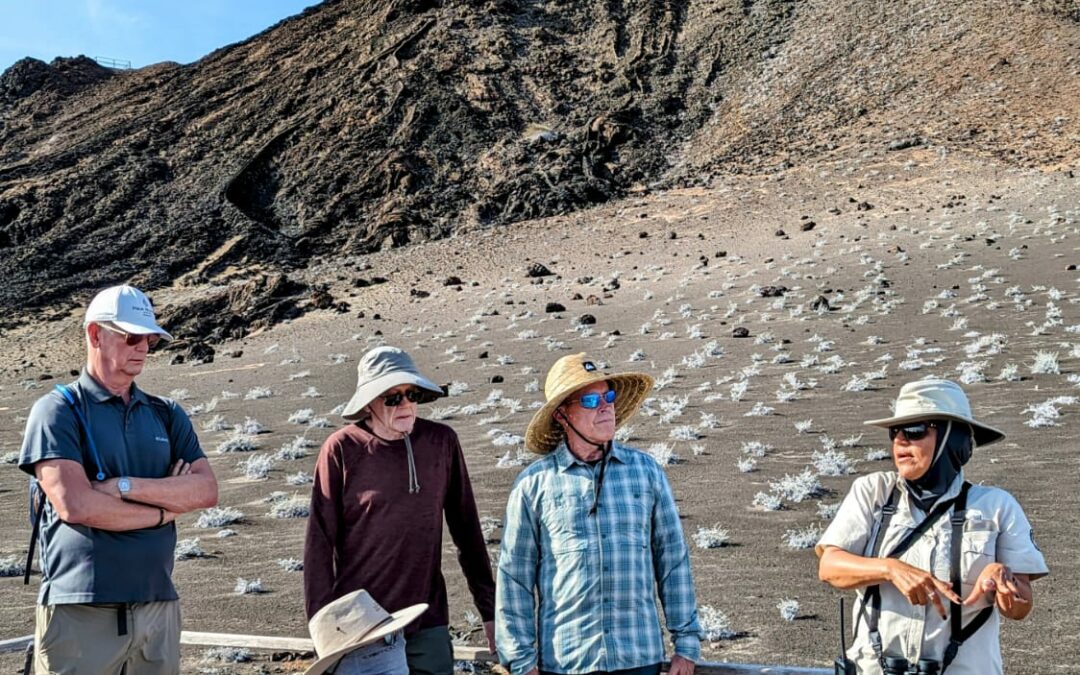
Call Us: 305-672-9779